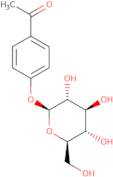
4-Acetylphenyl-β-D-glucopyranoside
CAS: 530-14-3
Ref. 3D-MA04949
| 25mg | 222.00 € | ||
| 50mg | 292.00 € | ||
| 100mg | 488.00 € | ||
| 250mg | 931.00 € | ||
| 500mg | 1,403.00 € |
Product Information
- PiceinAmeliarosidePiceosidep-Hydroxyacetophenone-D-glucosideSalinigrin
- 1-(4-(beta-D-Glucopyranosyloxy)phenyl)ethan-1-one
- 1-[4-(β-<span class="text-smallcaps">D</span>-Glucopyranosyloxy)phenyl]ethanone
- 4-Acetylphenyl β-<span class="text-smallcaps">D</span>-glucopyranoside
- 4-acetylphenyl beta-D-glucopyranoside
- Ameliaroside
- Ethanone, 1-[4-(β-<span class="text-smallcaps">D</span>-glucopyranosyloxy)phenyl]-
- Picein
- Piceoside
- Salicinerein
- See more synonyms
- Salinigrin
- p-Hydroxyacetophenone glucoside
- p-Hydroxyacetophenone-<span class="text-smallcaps">D</span>-glucoside
- Ethanone, 1-[4-(β-D-glucopyranosyloxy)phenyl]-
- 1-[4-(β-D-Glucopyranosyloxy)phenyl]ethanone
4-Acetylphenyl-β-D-glucopyranoside (4APG) is a natural compound that belongs to the group of p-hydroxybenzoic acid. It has been shown to have antibacterial properties, with an optimum pH of 5.0 and an MIC of 1.0 μg/mL. 4APG was found to be active against Gram-positive bacteria, including Staphylococcus aureus, Bacillus subtilis, and Clostridium perfringens. This compound also inhibits the growth of Gram-negative bacteria such as Escherichia coli, Salmonella enteritidis, and Shigella dysenteriae. The chemical structure of 4APG was determined by NMR spectroscopy analysis and HPLC analysis. Analysis by GCMS revealed that 4APG contains protocatechuic acid, 5-caffeoylquinic acid, and other unknown compounds.
Chemical properties
Technical inquiry about: 3D-MA04949 4-Acetylphenyl-β-D-glucopyranoside
If you want to request a quotation or place an order, please instead add the desired products to your cart and then request a quotation or order from the cart. It is faster, cheaper, and you will be able to benefit from the available discounts and other advantages.





